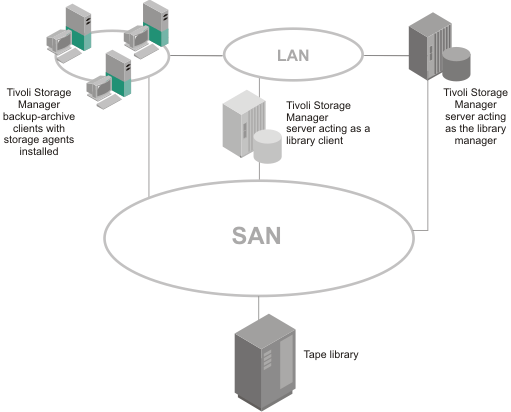When Tivoli® Storage Manager servers share an ACSLS, SCSI tape, virtual tape library (VTL), or 349x tape library device, one server, the library manager owns, and controls the device.
The library manager operations include checking volumes into and out of the library, labeling volumes, mounting and dismounting volumes, auditing volumes, and tracking an inventory of library contents. The storage agents, along with other Tivoli Storage Manager servers that share this library are library clients. As a library client, the storage agent stores data and requests drives, tapes, and volumes.
When the Tivoli Storage Manager server is also the library manager for the devices where data is stored by the storage agent, the storage agent communicates requests to this Tivoli Storage Manager server. When the Tivoli Storage Manager server is another library client, the storage agent communicates requests for itself or the metadata server directly to the library manager.
The library manager server can support library clients that are at the same or earlier version as the library manager. Library clients at a higher version than the library manager are not supported. When you use a shared ACSLS library, the library manager must be a Tivoli Storage Manager server on a AIX®, HP-UX, Linux, Solaris, or Windows operating system.
A library client requests shared library resources, such as drives or media, from the library manager, but uses the resources independently. The library manager coordinates the access to these resources. Data moves over the SAN between the storage device and either the library manager or the library client. Either the library manager or any library client can manage the LAN-free movement of client data when the client system includes a storage agent.
- Migrations
- Expiration of files that is based on policy information
- Reclamation of free space on volumes and consolidation of the volumes
- Disaster recovery
The following library manager and library client configurations are represented in Figure 1:
- A Tivoli Storage Manager server library manager manages data of a client, which is stored in a tape library.
- A Tivoli Storage Manager server library client manages data of a client, which is stored in a tape library.

- An environment can have a library manager without a library client.
- In an environment where ACSLS library support is required, the library client and library manager can be on a Tivoli Storage Manager server on AIX, HP-UX, Linux, Solaris, or Windows.